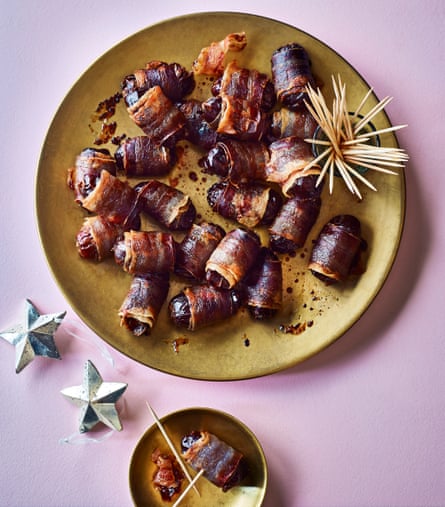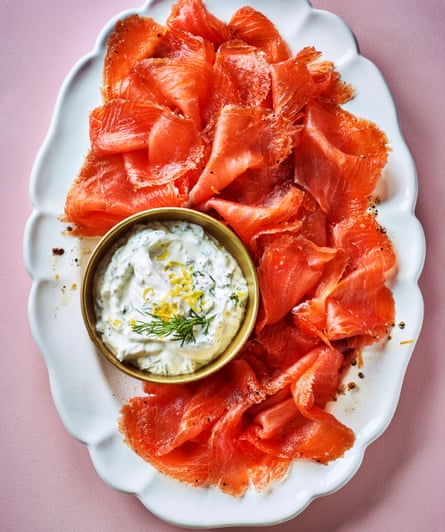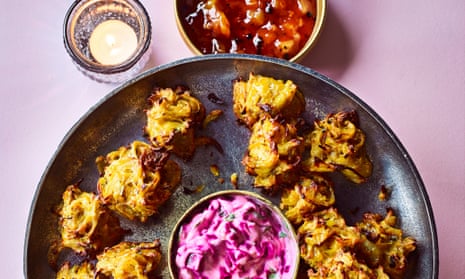Meera Sodha’s baked onion bhajis
These are a step forward from the deep-fried favourites: they are healthier, more pleasant to cook, and just as tasty. I like to serve these with a fresh coriander or mango chutney, or beetroot raita.
Makes 24
ginger 3cm, peeled and roughly chopped
green finger chilli 1, chopped
cumin seeds 2 tsp
salt
brown onions 1kg
rapeseed oil 4 tbsp
chickpea (gram) flour 180g
fresh coriander 40g, roughly chopped
red chilli powder ½ tsp
ground coriander 1 tsp
ground turmeric ½ tsp
lemon juice 1 tbsp
Preheat the oven to 180C/gas mark 4 and line two baking trays with lightly oiled foil. Put the ginger, green chilli and cumin seeds into a pestle and mortar along with a small pinch of salt, bash to a coarse paste and leave to one side.
Peel and halve the onions, then slice them into ½cm half-moon shapes. Put the oil into a large frying pan over a medium heat and, when hot, add the onions. Fry for around 15 minutes, stirring occasionally, until they’re translucent and just soft enough to cut with a wooden spoon.
Put the onions into a bowl and add the ginger, green chilli and cumin paste, along with the chickpea flour, fresh coriander, red chilli powder, ground coriander, turmeric, lemon juice and 1½ teaspoons of salt. Mix thoroughly and, little by little, add up to 30ml of water, until you have a very thick batter.
Take a tablespoon of the mixture and drop it on to a tray. Repeat with the rest of the mix, leaving a couple of centimetres between each bhaji.
Bake for 25-35 minutes, until the bhajis start to crisp up and brown on top. Remove from the oven – you may need to gently lever them off the foil using a palette knife – and place on a plate alongside some chutney before devouring.
From Fresh India by Meera Sodha (Penguin Fig Tree, £20)
Nigella Lawson’s drunken devils on horseback

Makes 24
ready-to-eat, stoneless dried prunes 24
armagnac 90ml
American-style bacon rashers 12 (see note) or 24 thin slices of pancetta
The day before your party, soak the prunes in the armagnac in a covered bowl.
On the day, preheat the oven to 200C/gas mark 6.
On a board, spread out a rasher of bacon and cut in half horizontally to give 2 shorter pieces, or use a whole pancetta slice. Then take a soaked prune from your bowl and roll it up in one of the half pieces of bacon, or a pancetta slice, securing it with a cocktail stick. Repeat this process with the remaining prunes, wrapping each in bacon, and place them on a lined baking sheet.
Cook the drunken devils in the oven for 10-15 minutes, then let them cool a little, to avoid burnt fingers and mouths, before plating them up to serve.
Note: These 24 prunes use up exactly 1 x 200g packet of Oscar Mayer American-style bacon or use rindless streaky bacon.
From Nigella Christmas by Nigella Lawson (Chatto & Windus, £20)
Trine Hahnemann’s Christmas salmon

You need to start this recipe three days ahead.
Serves 8-10 people
whole coriander seeds 2 tbsp
whole cloves 1 tbsp
whole black peppercorns 2 tbsp
unwaxed orange finely grated zest of 1
flaky sea salt 150g, or fine sea salt
sugar 150g
side of salmon 1.2 kg, skin on
toasted rye bread to serve
For the citrus cream
full-fat Greek yogurt 200g (10% fat content)
unwaxed lemon finely grated zest of 1
lemon juice 2 tbsp
fresh thyme 1 tbsp, chopped
fresh dill 4 tbsp, chopped
salt and freshly ground pepper
Using a pestle and mortar, lightly crush the coriander seeds, cloves and peppercorns together. Add to the bowl with the orange zest, the salt and sugar and mix well.
Line a ceramic dish at least 40cm long with clingfilm, letting it overhang the sides, and place the salmon fillet skin-side down inside the dish. Spoon the spice cure evenly over the salmon, making sure the whole fillet is covered. Wrap the clingfilm tightly around the fillet so the mixture stays in place. Refrigerate for 3 days to cure.
Rinse the cure mixture off and make sure to wipe the fish clean.
For the citrus cream, mix the yogurt with lemon zest and juice, thyme and dill, and season to taste with salt and pepper.
Cut the salmon away from the skin into thin slices and serve with citrus cream and rye toast.
Trine Hahnemann is a Copenhagen-based chef and food writer
The Guardian and Observer aim to publish recipes for sustainable fish. For ratings in your region, check: UK; Australia; US
Nicola Hordern’s crisps with Italian autumn truffle and creme fraiche

You can play with the flavours here – using dried seaweed (nori or dulse) instead of ceps and trout or salmon roe instead of truffle makes an equally delicious combination.
Serves 4-6
floury potatoes 1kg, suitable for frying, eg Maris Piper or King Edward
vegetable oil
dried ceps a few handfuls, or other mixture of dried wild mushrooms
creme fraiche 1 x 280g tub (we use Marybelle)
Italian autumn truffle 1, or Wiltshire autumn truffle
To make the crisps, peel the potatoes and, using a mandoline, finely slice the potatoes to around 3mm thick. Too thin and they will disintegrate when eating, too thick and you won’t achieve that essential crunch. They will all need to be of a similar size to ensure they cook evenly.
Put the sliced potatoes under running water, swirling them around every so often to remove the starch and then pat dry using a clean tea towel.
Either using a deep fat fryer or a deep pan filled to around a third with oil, heat the oil to 165C and, cooking in batches, gently drop in the potatoes. Don’t overfill the pan as they will start to steam and not crisp up. Move the crisps around gently in the pan to stop them sticking and, once they are crisp and have sufficient colour, remove from the pan and place in a bowl lined with kitchen towel and sprinkle with salt. Do this until all of the potatoes are cooked. The potatoes should cook quite quickly – if you leave them for too long on a low heat they become greasy; too hot and you will have quickly cooked, burnt crisps.
Make a cep powder by popping a handful or 2 of dried ceps into a blender – a Nutribullet would be ideal for the job – and blitz until you have a fine powder.
Dollop some creme fraiche on a plate or platter, pile some crisps on top, sprinkle with cep powder and then either finely slice the truffle on top using a mandoline or truffle shaver or grate using a Microplane. Be generous!
Nicola Hordern is the head chef at Darsham Nurseries, Suffolk
Rosio Sanchez’s churros with goat’s milk cajeta

You can keep uncooked churros in the freezer and fry them whenever you need them.
Makes approximately 40 churros
grapeseed oil for frying
For the goat’s milk cajeta
UHT goat’s milk 1 litre
sugar 300g
baking powder 30g
salt to taste
For the cinnamon sugar
caster sugar 100g, or to taste
ground cinnamon 1 tbsp, or to taste
For the churro dough
sugar 20g
water 800ml
salt 8g
butter 100g
‘00’ flour 700g
eggs 3
salt
First, make the cajeta. Combine all the ingredients together in a pot and cook on medium heat until the consistency is that of a caramel. This will take a couple of hours. When it has reached a medium caramel colour, take it off the heat to cool and then store it in the fridge until ready to use. (The cajeta should be dark, but still quite runny. It should not be set.)
Make the cinnamon sugar by mixing sugar and cinnamon to taste. Set aside till needed.
For the churro dough, on high heat boil everything together in a pot, except for the eggs and flour. This should be done only until the butter has just melted.
Gradually add the sifted flour and use a firm spatula to incorporate it thoroughly. You will need to work this dough in the pot so that it forms a firm consistency. This will take some minutes as you need to make sure all the moisture is cooked out of the dough.
Transfer the dough to a stand mixer with a paddle attachment. Paddle on a low speed. Begin to incorporate the eggs one at a time, making sure each egg is mixed thoroughly before adding more. This should only take a few minutes. Keep scraping down the side of the bowl to ensure the dough is fully incorporated.
Fit a large star pastry tip (the width you prefer) into a reusable pastry bag. The dough is quite firm, so it needs to be a reusable bag – if you use a disposable pastry bag, it might tear. While the dough is still warm, pipe the churros onto a tray lined with parchment paper, making the logs about 2cm in length. Make sure the mini churros do not touch each other. If you’re making ahead, freeze them now on the tray.
Add grapeseed oil to pot to about about 3-4 cm deep. Heat the oil to 180C and, working in batches, fry the churros in the oil until they are golden brown, for about 3 minutes from frozen. Using long tongs to turn them over so that they fry evenly.
Drain the churros on a paper towel and, while still warm, roll them in cinnamon sugar. Serve warm with room-temperature cajeta in a bowl on the side.
Rosio Sanchez is the chef-founder of Sanchez, Copenhagen

Comments (…)
Sign in or create your Guardian account to join the discussion